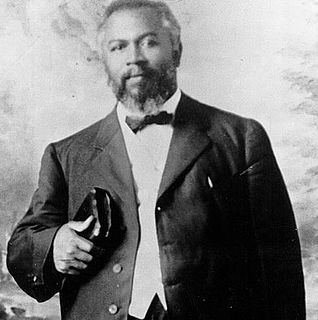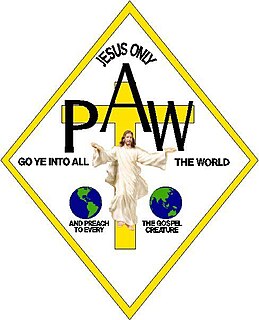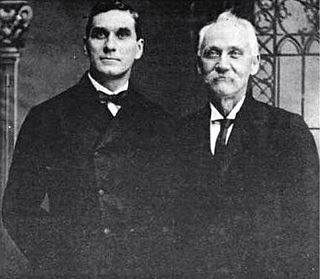Related Research Articles

Pentecostalism or classical Pentecostalism is a Protestant Charismatic Christian movement that emphasizes direct personal experience of God through baptism with the Holy Spirit. The term Pentecostal is derived from Pentecost, an event that commemorates the descent of the Holy Spirit upon the followers of Jesus Christ, and the speaking in "foreign" tongues as described in the second chapter of the Acts of the Apostles. In Greek, it is the name for the Jewish Feast of Weeks.
The Apostolic Faith Church, formerly the Apostolic Faith Mission, is a Pentecostal Christian denomination, with nationwide reach and headquartered in Portland, Oregon, United States. The Apostolic Faith Mission of Portland was founded in 1907 by Florence L. Crawford, who was affiliated with William J. Seymour and the Azusa Street Revival of Los Angeles, California. By 1908 Crawford had independently founded what would become the Apostolic Faith Church. Since July 2000, the Superintendent General of the Apostolic Faith Church has been Darrel Lee.

Restorationism is the belief that Christianity has been or should be restored along the lines of what is known about the apostolic early church, which restorationists see as the search for a purer and more ancient form of the religion. Fundamentally, "this vision seeks to correct faults or deficiencies by appealing to the primitive church as a normative model."

Oneness Pentecostalism is a nontrinitarian religious movement within the Protestant Christian family of churches known as Pentecostalism. It derives its distinctive name from its teaching on the Godhead, which is popularly referred to as the Oneness doctrine, a form of Modalistic Monarchianism. This doctrine states that there is one God, a singular divine spirit with no distinction of persons who manifests himself in many ways, including as Father, Son, and Holy Spirit. This stands in sharp contrast to the doctrine of three distinct and eternal persons posited by Trinitarian theology.
The Azusa Street Revival was a historic series of revival meetings that took place in Los Angeles, California. It was led by William J. Seymour, an African-American preacher. The revival began on April 9, 1906, and continued until roughly 1915. On the night of April 9, 1906, Seymour and seven men were waiting on God on Bonnie Brae Street, "when suddenly, as though hit by a bolt of lightning, they were knocked from their chairs to the floor," and the other seven men began to speak in tongues and shout out loud praising God. The news quickly spread; the city was stirred; crowds gathered; and a few days later Seymour himself received the Holy Spirit; services were moved outside to accommodate the crowds who came from all around; people fell down under the power of God as they approached; people were baptized in the Holy Spirit and the sick were healed and sinners received salvation. The testimony of those who attended the Azusa Street Revival was "I am saved, sanctified, and filled with the Holy Ghost" in reference to the three works of grace of Holiness Pentecostals, the original branch of Pentecostalism. To further accommodate the crowds, an old dilapidated, two-story frame building at 312 Azusa Street in the industrial section of the city was secured. This building, originally built for an African Methodist Episcopal (AME) church, had more recently been used as a livery stable, storage building and tenement house. In this humble Azusa Street mission, a continuous three-year revival occurred and became known around the world. Stanley H. Frodsham, in his book, With Signs Following, quotes an eye-witness description of the scene: The revival was characterized by spiritual experiences accompanied with testimonies of physical healing miracles, worship services, and speaking in tongues. The participants were criticized by some secular media and Christian theologians for behaviors considered to be outrageous and unorthodox, especially at the time. Today, the revival is considered by historians to be the primary catalyst for the spread of Pentecostalism in the 20th century.

William Joseph Seymour was an African-American holiness preacher who initiated the Azusa Street Revival, an influential event in the rise of the Pentecostal and Charismatic movements. He was the second of eight children born to emancipated slaves and raised Catholic in extreme poverty in Louisiana.

Charles F. Parham was an American preacher and evangelist. Together with William J. Seymour, Parham was one of the two central figures in the development and early spread of American Pentecostalism. It was Parham who associated glossolalia with the baptism in the Holy Spirit, a theological connection crucial to the emergence of Pentecostalism as a distinct movement. Parham was the first preacher to articulate Pentecostalism's distinctive doctrine of evidential tongues, and to expand the movement.
Sacred tradition is a theological term used in Christian theology. According to the theology of the Catholic, Eastern Orthodox, Oriental Orthodox and Assyrian churches, sacred tradition is the foundation of the doctrinal and spiritual authority of Christianity and of the Bible. Thus, the Bible must be interpreted within the context of sacred tradition and within the community of the church. The Anglican and Methodist churches regard tradition, reason, and experience as sources of authority but as subordinate to scripture – a position known as prima scriptura. That is in contrast to the Lutheran and Reformed traditions, which teach that the Bible alone is a sufficient basis for all Christian teaching – a position known as sola scriptura.

The New Apostolic Church (NAC) is a Christian church that split from the Catholic Apostolic Church during an 1863 schism in Hamburg, Germany.

The Pentecostal Assemblies of the World, Inc. (P.A.W.) is one of the world's largest Oneness Pentecostal denominations, and is headquartered in Indianapolis, Indiana. While it began in 1906 with Trinitarian beliefs, it was re-organized in 1916 as Oneness Pentecostal, thus making it the oldest organization of this type.

Catholicity is a concept pertaining to beliefs and practices widely accepted across numerous Christian denominations, most notably those that describe themselves as catholic in accordance with the Four Marks of the Church, as expressed in the Nicene Creed of the First Council of Constantinople in 381: "[I believe] in one, holy, catholic, and apostolic Church."

The Apostolic Faith Mission of South Africa (AFM) is a classical Pentecostal Christian denomination in South Africa. With 1.2 million adherents, it is South Africa's largest Pentecostal church and the fifth largest religious grouping in South Africa representing 7.6 percent of the population. Dr. Isak Burger has led the AFM as president since 1996 when the white and black branches of the church were united. It is a member of the Apostolic Faith Mission International, a fellowship of 23 AFM national churches. It is also a member of the South African Council of Churches.
The Four Marks of the Church, also known as the Attributes of the Church, describes four distinctive adjectives of traditional Christian ecclesiology as expressed in the Niceno-Constantinopolitan Creed completed at the First Council of Constantinople in AD 381: "[We believe] in one, holy, catholic, and apostolic Church."
The Apostolic Faith Mission Church of God is a Pentecostal Christian denomination founded in 1906 by F. W. Williams. In 2005, there were 10,730 members in 18 congregations.

An apostle, in its literal sense, is an emissary, from Ancient Greek ἀπόστολος (apóstolos), literally "one who is sent off", from the verb ἀποστέλλειν (apostéllein), "to send off". The purpose of such sending off is usually to convey a message, and thus "messenger" is a common alternative translation; other common translations include "ambassador" and "envoy". The term in Ancient Greek also has other related meanings.

Thomas Hezmalhalch, usually known as Tom Hezmalhalch, was an American missionary, who together with John G. Lake founded the Apostolic Faith Mission of South Africa and was its first chairman and president. He was influenced by the healing ministry of John Alexander Dowie.
Pentecostalism is a renewal movement within Protestant Christianity that places special emphasis on a direct personal experience of God through the baptism with the Holy Spirit. For Christians, this event commemorates the descent of the Holy Spirit upon the followers of Jesus Christ, as described in the second chapter of the Book of Acts. Pentecostalism was established in Kerala at the start of the 20th century.
Pentecostalism began spreading in South Africa after William J. Seymour, of the Azusa Street mission, sent missionaries to convert and organize missions. By the 1990s, approximately 10% of the population of South Africa was Pentecostal. The largest denominations were the Apostolic Faith Mission, Assemblies of God, and the Full Gospel Church of God. Another 30% of the population was made up of mostly black Zionist and Apostolic churches, which comprise a majority of South Africa's African Instituted Churches(AICs). In a 2006 survey, 1 in 10 urban South Africans said they were Pentecostal, and 2 in 10 said they were charismatic. In total, renewalists comprised one-fourth of the South African urban population. A third of all protestants surveyed said that they were Pentecostal or charismatic, and one-third of all South African AIC members said they were charismatic.
The doctrines and practices of modern Pentecostalism placed a high priority on international evangelization. The movement spread to Africa soon after the 1906 Azusa Street Revival in Los Angeles.
References
- 1 2 3 Lewis, James R. (1998). The Encyclopedia of Cults, Sects, and New Religions. Amherst, New York: Prometheus Books. ISBN 1-57392-222-6.